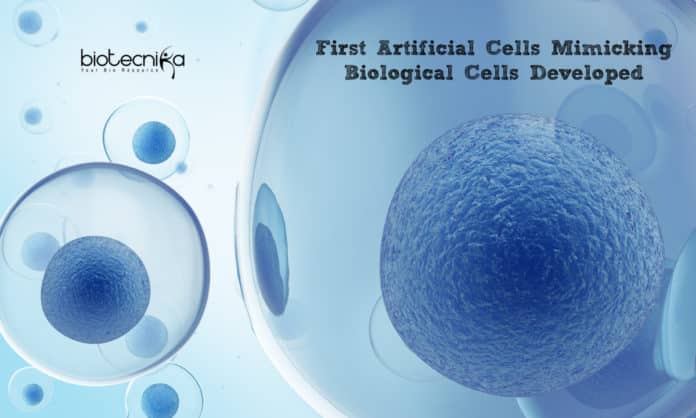First Artificial Cells Mimicking Biological Cells Developed By Researchers
Imperial College London scientists have developed synthetic – artificial cells that simulate biological naturally occurring cells by responding to a chemical change in their environments. The artificial cells could be utilized to sense adjustments in the body and also respond by releasing medication molecules or to sense and remove toxic metals in the atmosphere.
Responding to chemical modifications is an essential function of biological cells. For example, cells can react to chemicals by producing specific proteins, boosting power production, or self-destructing. Chemicals are likewise made use of by cells to connect with each other and also coordinate feedback or send a signal, such as a pain impulse.
Nevertheless, in all-natural cells these chemical reactions can be really intricate, involving several actions. This makes them difficult to engineer, for example, if researchers wished to make natural cells produce something beneficial, like a drug molecule.
Rather, the Imperial scientists are producing man-made cells that simulate these chemical actions in a much simpler method, enabling them to be extra easily engineered.
Currently, the group has actually developed the very first artificial cells that can sense as well as react to an exterior chemical signal
with activation of a man-made signaling pathway. They developed cells that sense calcium ions as well as react by fluorescing (glowing). The outcomes of their research are published in the Journal – Proceedings of the National Academy of SciencesAuthor of the study – James Hindley, from the Division of Chemistry at Imperial, stated: “These systems can be created for use throughout biotechnology. We might envisage creating man-made cells that can pick up cancer markers and synthesize a medication within the body, or artificial cells that can pick up unsafe heavy steels in the atmosphere and also launch careful sponges to clean them up.”
The group created a synthetic cell that has smaller sized cells (‘vesicles’) within. The edge of the cell is developed of a membrane which contains pores, which permit calcium ions to get in. Inside the cell, the calcium ions trigger enzymes that create the blisters to release fragments that fluoresce.
James included: “Biology has actually developed to be durable by utilizing complex metabolic as well as regulatory networks. This can make modifying cells tough, as many existing chemical action paths are incredibly complicated to replicate or designer.
” Instead, we created a truncated version of a path found in nature, utilizing artificial cells and also elements from different natural systems to make a much shorter, a lot more efficient path that creates the very same results.”
The scientists’ system is less complex due to the fact that it doesn’t need to account for much of things cells need to get around in all-natural systems– such as byproducts that are harmful to the cell.
Within the system, the membrane pores and also the enzymes activated by calcium are from existing organic systems– the enzyme is taken from bee poison for instance– but they would not be located in the same atmosphere in nature.
The researchers state this is the toughness of using fabricated cells to produce chemical feedbacks– they can more easily mix aspects found apart in nature than they can include an outside aspect into an existing organic system.
Advances from chemistry, as well as nanotechnology, can also be incorporated, creating systems and pathways challenging to a designer in biology.
Co-author Professor Oscar Ces, from the Division of Chemistry at Imperial, stated: “The plug-and-play facet of our system suggests researchers can take elements from across nature to produce new chemical paths made with details objectives in mind.
” Our design template system is likewise simple to establish as well as can be used to quickly evaluate any brand-new combination of aspects scientists develop.”
































